Q&A – Ask Neil: July 6, 2023
(Please read these instructions carefully.)
Before you post your question, please look at recent issues to see if someone else has already asked it. You might find your answer there.
How to submit your question…
(Note: You may need to allow a pop-up window to come up in order to get the link for sending your photo(s). If you have already submitted your question and didn’t see the pop-up window, please click here.)
- Click the link provided below to post your question. After you submit your question, a new window will pop up giving you the address to which you can e-mail a SHARP, HIGH-RESOLUTION PHOTO to accompany your question. Please DO NOT SEND THUMBNAIL PHOTOS in case I need to zoom in to see things.
- Click here to post your question.
- Please ONLY POST YOUR QUESTION ONE TIME. We can only accept a set number of questions each week, and when we get duplicates it costs other people their chances.
- One question per reader, please.
- Please use this only for posting questions – not for standard emails.
- Watch for your answer in the following week’s e-gardens.
- I choose those of greatest general interest. For example, plant IDs seldom make the cut.
- I must have your first name or initials.
- I must have your city or county. (Texas is a very large state.)
QUESTION 1
IS THIS SUN SCALD? CAN THE TREE BE SAVED?
Question: This maple was like this when we bought the house. Is this sun scald? The trunk gets west sun with nothing blocking it. Can it be saved? J.M., Royse City.
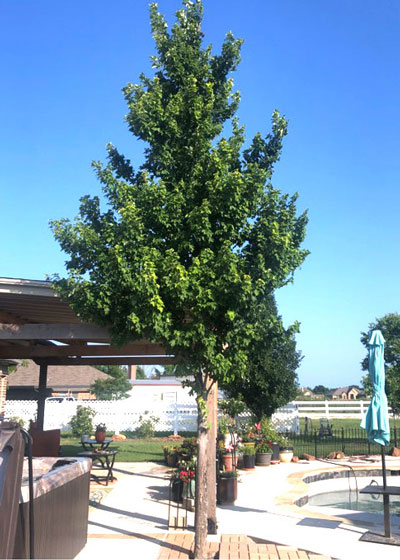
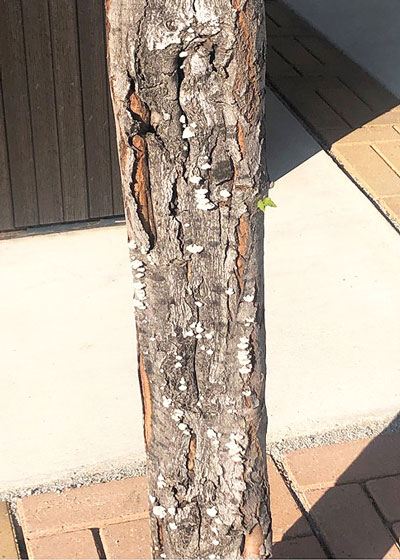
Answer: It’s a perfect example of sun scald to the trunk of a red maple. Your tree is trying to heal, and the top growth still looks reasonably healthy. Hopefully it will be able to maintain symmetrical growth without dieback on the damaged side. There is nothing you can do now other than wait to see. For anyone unfamiliar with this issue, thin-barked trees like red maples, Shumard red oaks, live oaks, Chinquapin oaks and Chinese pistachios need to be protected from intense sun from their lowest limbs to the ground with paper tree wrap for their first couple of years in your landscape. Damage like this doesn’t become evident until after four or five years.
QUESTION 2
HOW CAN I TRIM YAUPON HOLLIES IN FRONT OF MY HOUSE?
Question: How can I trim 25-year-old yaupon hollies across the front of my house? Some have dead spots from the cold last winter. How much can they be trimmed, and when should I do it? Sam S., Gainesville.
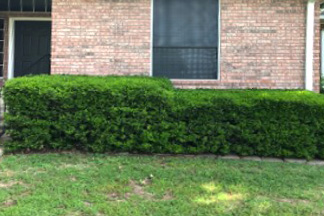
Answer: The best time to do extensive pruning would be late winter (early February), just before their burst of early spring growth. That’s the easy question. The more difficult part will be how to do it. If they were my plants, I would use a power hedge trimmer to reshape them into individual plants. That’s going to involve cutting them back by one-third or more, and that’s going to leave many of them completely bare. If you don’t prune them that much they will probably just get weaker and weaker. In all candor, I prefer to see my shrubs individually, so if I could prune in a way that I ended up with clusters of individual plants instead of one mass, I think the landscape would have a more natural look to it. Honestly, I just removed seven overgrown dwarf Chinese hollies beneath windows where I wanted the added protection of their spines. They had been there 42 years. My replacement plants are going to be slightly farther apart so that they can stand separately. Sometimes, after many years, we just get to a point where it’s easier to replace the old, misshapen plants.
QUESTION 3
WHY WOULD I HAVE GRASS DYING IN SPOTS?
Question: I have grass that’s dying in spots. I sprayed herbicide and insecticide. No results. No moles or gophers. No dogs. Bill W., Denison.
Answer: You’ve told me all the things it isn’t, but you didn’t give me any clues other than, “It’s dying in spots.” I don’t even know what type of grass is involved. A photo would really help as well. With nothing more than I have at this point, I can’t even start. I’m sorry.
QUESTION 4
WHAT CAUSES MY ASH TREE’S LEAVES TO CURL?
Question: I love my two ash trees, but every year one of them begins to have bits of leaves that curl and then that part of the branch dies. It is scattered over the tree. Any thoughts? Randi D., College Station.
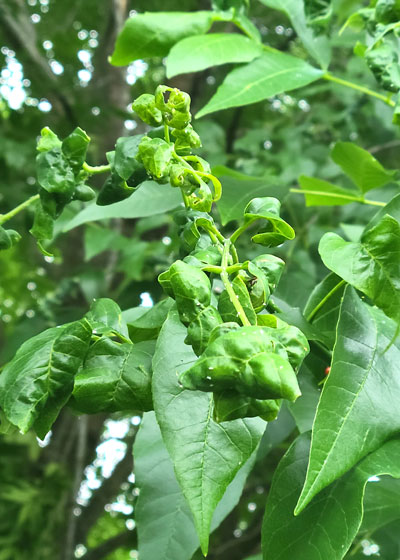
Answer: This is work of the leafcurl ash aphid. If you unroll one of these masses of leaves, you’ll find them wrapped up with a waxy, cottony covering. They affect only the new growth, and they are almost entirely cosmetic. If you Google “university leafcurl ash aphids” you will find many matches, including these:
Montana State University (I have never cited them before so I decided to give them top billing).
QUESTION 5
WHAT IS GOING ON WITH OUR ITALIAN CYPRESS?
Question: We have two Italian cypresses. One is fully green while the other has some brown spots. I have just seen these cocoon-like pods, 2 inches long, hanging on them. What is going on? Joseph R., Murphy.

Answer: These are the bagworms I’ve referred to several times here starting in late May. They’re the larval form of an inconspicuous moth, but their damage can be terrible. Italian cypresses have enough other troubles (freeze damage, spider mites, Seiridium canker) in North Texas that they don’t need the bagworms. You need to watch for them starting early June each year. When you see tiny versions of these bags moving around and the worms inside them feeding voraciously on the needles of your cypress, that’s the time to spray with almost any general-purpose insecticide. The organic spray B.t. works very well. However, once they tie themselves to the small twigs, spraying is of no use. All you can do then is pull them off by hand one at a time. In doing so you will be removing the overwintering larvae.
QUESTION 6
HOW DO I REMOVE THIS GRASSY WEED?
Question: How do I remove this grassy weed? Will a broadleafed weedkiller remove it? I tried it once and had no success. Beth S., Kinney.
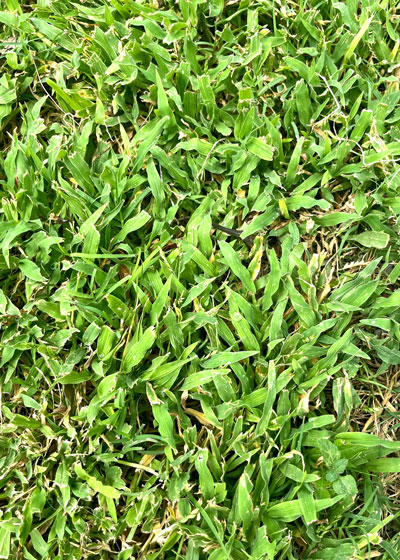
Answer: This looks like smooth crabgrass. If so, a broadleafed weedkiller won’t touch it. See the photos in this panel from Texas A&M turf specialists, most notably the last three toward the bottom of the stack. https://aggieturf.tamu.edu/turfgrass-weeds/smooth-crabgrass/.
I must admit, however, that I’m struggling with completing my answer. Your email address makes it sound like you’re on a ranch, which suggests Kinney County (Brackettville area), but I don’t see a city. And e-gardens is published in McKinney, in Collin County northeast of Dallas. The timing of your application of pre-emergent weedkiller would be quite different for these two locations. In Kinney County the last freeze comes earlier, so treat in mid-February, repeated mid-May, and repeated mid-August. Apply Halts, Dimension or Balan. The three applications do not have to match. For McKinney in Collin County, only two applications will be needed because of the shorter growing season. There is nothing you can do now for this year’s crop of weeds. However, do let it produce a couple of seed heads to be sure they match what you see in those photos on the link I’ve given you. That will confirm the identification – always a good plan!
QUESTION 7
WHAT CAN I DO TO HELP MY PEACH TREE?
Question: I received a peach tree via mail and planted it into a pot. I plan to give it to a friend. The lower leaves are now turning brown in large patches. Am I watering it too much or too little? Is there a fungus? Robert T., College Station.
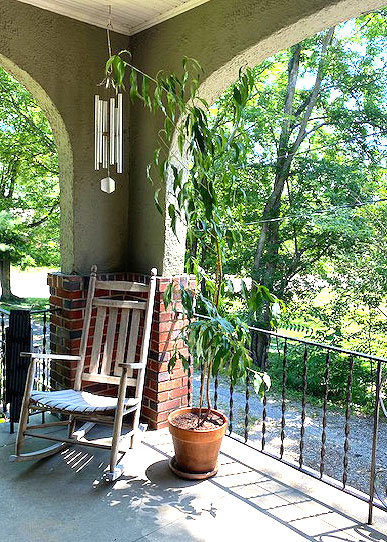
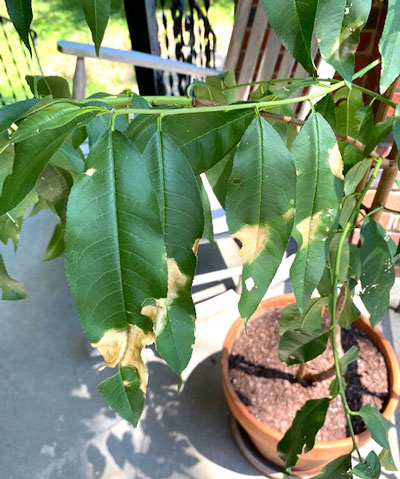
Answer: Honestly, I’m least worried about the spots on the lower leaves. Seeing the two photos together, I wonder if those leaves might have been against the wrought iron on a sunny, hot day. The browning looks more like scorch. It appears to me that the tree has gotten too dry more than once. It really needs to be repotted soon. It doesn’t have enough of a “reservoir” of soil to hold moisture for any period of time. The normal rule of thumb is that a container should be 1/4 to 1/3 the height or width of the plant that is growing in it. Your tree is 8 or 10 times taller than the pot. Also, peach trees need to be pruned at 24 to 26 inches from the ground to encourage the development of three “scaffold” branches extending out at 120-degree angles around the trunk. That will help distribute the weight of the ripening fruit as the tree grows. You’ll find many sources of information on how to prune peaches online and even in my book I advertise here in e-gardens. Finally, peach trees really need to be in full sun. A bit of shade wouldn’t be too bad, but this looks like it’s getting far too much shade. I hope all of this hasn’t sounded too harsh, but the spots on the leaves are not a big issue compared to the others. Good luck!
QUESTION 8
WHAT IS CAUSING THIS DARK SPOT ON THE TRUNK OF MY OAK?
Question: My son brought this tree home from the very first Arbor Daze in Euless. I believe that was around 1990. What is now causing the dark spot on its trunk? Otherwise, the tree seems very healthy. Joan B., Euless, Tarrant Co.
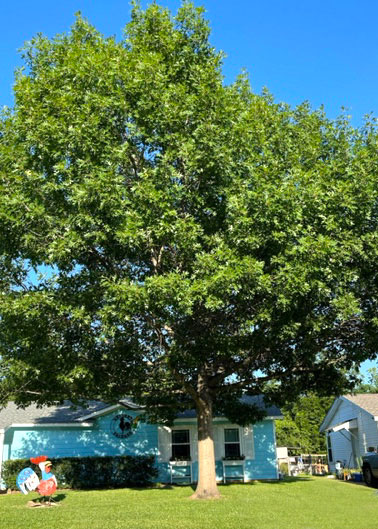

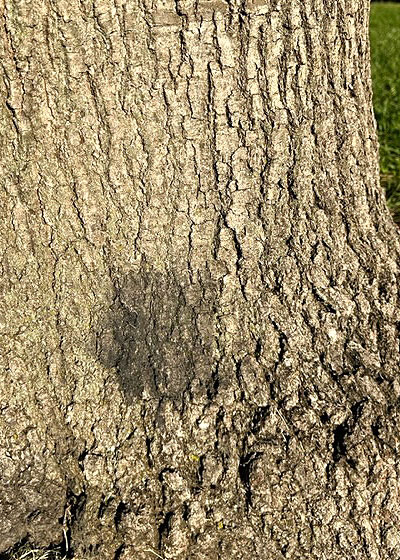
Answer: It may be nothing to worry about, but it could also be moisture collecting from a spot of decay beneath the bark. I would suggest that you have a certified arborist examine the tree carefully. If you have one with whom you already work, ask him or her to look at it soon. If you need a referral, our advertiser here, Arborilogical Services of DFW, certainly has people with the backgrounds and skills to help you. The arborist will probably want to collect a small sample and have it cultured by the Texas A&M Plant Disease Clinic.
QUESTION 9
HOW CAN I ELIMINATE THIS WEEDY VINE?
Question: How can I eliminate this vine that is growing along a wall in my backyard? Digging it out has not worked because its roots have these long “nodules,” and they make it difficult to kill the entire vine. Ron Z., Colleyville.
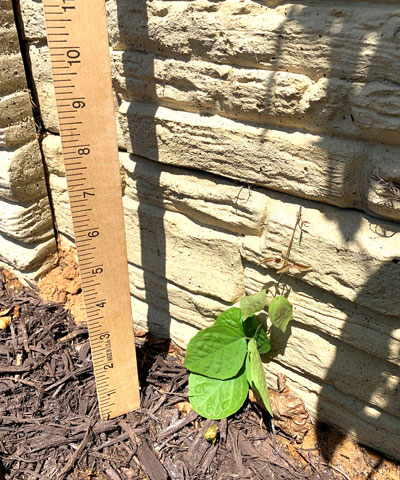
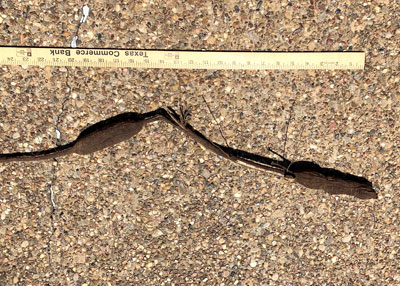
Answer: It’s a good question. I would spray existing foliage with a broadleafed weedkiller (containing 2,4-D). I would also scratch the exposed stems and roots and carefully ladle the same broadleafed weedkiller onto the stem tissues. Take care not to soak the soil with the herbicide, however. Be persistent if necessary.
QUESTION 10
WHAT IS KILLING OUR HACKBERRIES?
Question: We lost four large (9 to 12-inch diameter) hackberry trees. Something ate between the bark and the rest of the trunks. I sprayed for carpenter ants and termites. What do you suggest? David W., Cleburne.
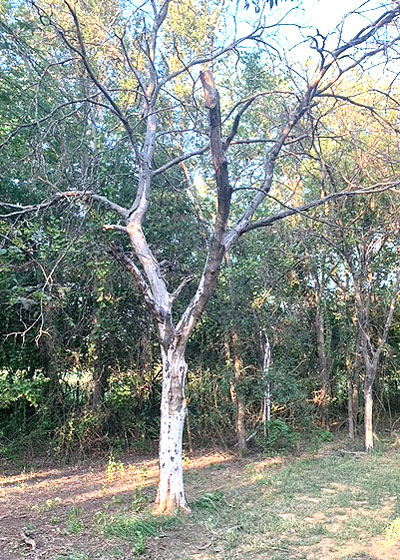
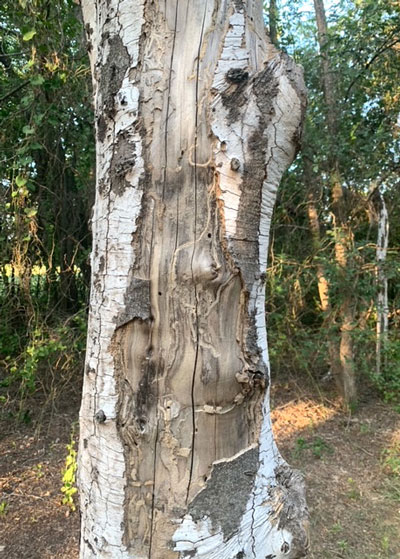
Answer: Hackberries have short life expectancies. The one that is prominent in your photo, and perhaps the ones in the woods in the background, have not been vigorous due to a large amount of competition. What you are seeing beneath the bark is borer tunneling. Borers move in after a hackberry has been compromised by something else. I’ve been around hackberries all of my life (including over the past 45 years on our 11 acres), and this is the way they handle competition. (Not very well.) As your wooded area opens up I’d suggest you replace them with a more durable tree species such as an oak, pecan, or cedar elm.
QUESTION 11
HOW CAN I KILL A CRAPE MYRTLE STUMP?
Question: I had to have a large crape myrtle taken out right at the corner of our house. Now I’m told that before they can grind the stump, I have to kill it. How can I do that? Ellen G., Plano.
Answer: Drill into the stump with a large bit (finger-sized). Make multiple holes a couple of inches deep but take care not to crack the stump. Blow them clean of all sawdust. Ladle a broadleafed weedkiller at full strength into the holes and let it soak into the wood. Once it has done so, add the same amount a second time. It will be carried all through the plant’s root system.
QUESTION 12
IS THIS IRON DEFICIENCY? WHAT CAN I DO FOR THIS PROBLEM?
Question: I’m having problems with what I think might be iron deficiency with my vitex and beautyberries. The symptoms look like what you describe. What should I do to correct the problems? Sonja A., Lake Palo Pinto.
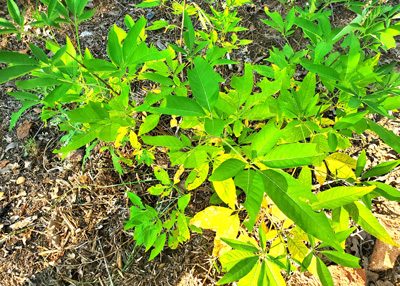
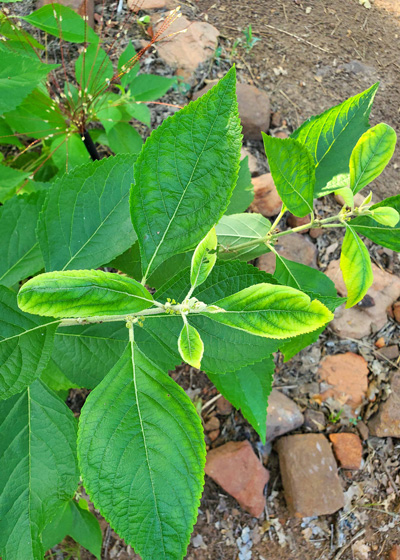
Answer: The vitex definitely does not look like iron deficiency. It looks like the yellowed leaves are almost all older leaves. If I had to guess, I’d say that this plant has been lacking adequate water and nitrogen. I’d suggest applying a very high-nitrogen lawn food. You could even try a water-soluble nitrogen houseplant food just to see if you got an incredibly fast response. It also looks like leaf cutter bees have visited this plant, as judged by the semi-circular holes they have cut from the leaf margins. They’re harmless, as you may have seen in the story I wrote about them here a week or two back.
As for the beautyberry, that really doesn’t look like iron deficiency, either. Since you have it growing in native soil and not in some kind of laboratory setting with artificial, sterile potting soil, I’m going to rule out minor elements. I would try the same application of nitrogen and water. Beautyberries wilt daily if they’re not kept moist. Keep the hose handy.
